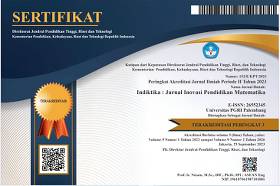STRATEGI SISWA SMP DALAM GENERALISASI HUBUNGAN KOVARIASI
DOI:
https://doi.org/10.31851/indiktika.v2i2.4101Keywords:
generalisasi, hubungan kovariasi, hubungan fungsionalAbstract
ABSTRAK
Salah satu aktivitas dalam belajar matematika adalah melakukan generalisasi. Hubungan fungsional terbagi menjadi dua yaitu hubungan kovariasi dan hubungan korespondensi. Generalisasi hubungan kovariasi merupakan suatu proses untuk mendapatkan suatu pernyataan tentang hubungan perubahan dua kuantitas. Proses tersebut terdiri dari relating, searching dan extending. Penelitian ini bertujuan untuk mendeskripsikan strategi yang digunakan dalam generalisasi hubungan kovariasi pada siswa SMP. Penelitian ini dilaksanakan di SMP Negeri 1 Jombang dan SMP Negeri 2 Jombang, pada semester ganjil tahun pelajaran 2018/2019. Penelitian ini merupakan penelitian kualitatif, pengumpulan datanya melalui think aloud dan wawancara. Subjek dalam penelitian ini ada 2 siswa SMP yang dipilih dari 26 siswa yang melakukan generalisasi hubungan kovariasi. Subjek pertama melakukan generalisasi hubungan kovariasi dengan menggambar model dan menghitung banyaknya pot dan persegi pada setiap model menggunakan operasi perkalian. Sedangkan subjek kedua melakukan generalisasi hubungan kovariasi dengan memperhatikan banyaknya pot dan persegi pada model sebelumnya. Berdasarkan hasil pekerjaan subjek dan wawancara dapat disimpulkan bahwa subjek pertama menggunakan strategi counting dan subjek kedua menggunakan strategi recursion.
Kata kunci : generalisasi, hubungan kovariasi, hubungan fungsional
ABSTRACT
One of the activities in learning mathematics is to make generalizations. Functional relationships are divided into two, namely covariation relationship and correspondence relationship. The generalization of a covariation relationship is a process for obtaining a statement about the relationship of changes in two quantities. The process consists of relating, searching, and extending. This study aims to describe the strategies used in generalizing the covariation relationship in junior high school students. This research was carried out in SMP Negeri 1 Jombang and SMP Negeri 2 Jombang, in the odd semester of the academic year 2018/2019. This research is qualitative research with data collection through think aloud and interviews. The subjects in this study were 2 junior high school students selected from 26 students who generalized the covariation relationship. The first subject generalized the covariation relationship by drawing the model and calculating the number of pots and squares in each model using multiplication operations. Otherwise, the second subject generalized the covariation relationship by observing the number of pots and squares in the previous model. Based on the results of the subject's works and interviews, it can be concluded that the first subject uses the counting strategy and the second subject uses the recursion strategy.Â
Keywords : generalization, covariation relationship, functional relationship
References
Canadas, M.C., Brizuela, B.M., Blanton, M. 2016. Second graders articulating ideas about linear functional relationships. The Journal of Mathematical Behavior, Vol. 41: 87 – 103.
Carraher, D.W., Martinez, M.V., Schliemann, A.D. 2008. Early algebra and mathematical generalization. ZDM Mathematics Education, Vol. 40 : 3 – 22.
Confrey, J., dan Smith, E. 1995. Splitting, covariation, and their role in the development of exponential function. Journal for Research in Mathematics Education, Vol. 26 : 66 – 86.
Cooper, T., dan Warren, E. 2011. Year 2 to Year 6 Students’ Ability to Generalize: Models, Representations and Theory for Teaching and Learning. In Early Algebraization: A Global Dialogue from Multiple Perspectives. Heidelberg: Springer.
Creswell, J. 2010. Research Design : Qualitative, Quantitative and Mixed Methods Approaches. California: Saga Publication.
Creswell, J.W. 2012. Educational research : planning, conducting and evaluating quantitative and qualitative research. Pearson Education Inc.
Dumitrascu, G. 2017. Understanding The Process of Generalization in Mathematics Through Activity Theory. International Journal of Learning, Teaching and Educational Research, Vol.16(12): 46–69.
Ellis, A. B. 2007. Taxonomy for categorizing generalizations : generalizing action and reflection generalization. The Journal of The Learning Science, Vol. 16 : 221 – 261.
Kaput, J. 1999. Teaching and Learning a New Algebra with Understanding. In Mathematics Classroom that Promote Understanding. Mahwah, NJ: Erlbaum.
Kieran, C. 2007. Learning and Teaching Algebra at The Middle School Through College Levels: Buliding Meaning for Symbols and Their Manipulation. In Second Handbook of Research on Mathematics Teaching and Learning. Greenwich: Information Age Publishing.
Lannin, John K. 2003. Developing Algebraic Reasoning Through Generalization. Mathematics Teaching in The Middle School. NCTM.
Mason, J., Stacey, K., & Burton, L. 2010. Thinking Mathematically. Edinburgh: Pearson.
Moleong, L.J. 2007. Metodologi penelitian kualitatif. Bandung: Remaja Rosdakarya.
National Research Council. 2001. Adding it Up: Helping Children Learn Mathematics. Washington, DC: National Academy of Sciences.
NCTM. 2000. Principles and Standars for School Mathematics. Reston, VA: NCTM.
NCTM. 2006. Curriculum Focal Points K-8. Reston, VA: NCTM.
Panorkou, N., Maloney, A.P., Confrey, J. 2014. Expressing covariation and correspondence relationships in elementary schooling. NCTM.
Strachota, S. 2016. Conceptualizing Generalization. IMVI Open Mathematical Education Notes, Vol. 6:41–45.
Yilmaz, R., Argun, Z., dan Keskin, M.O. 2009. What is the Role Visualization in Generalization Processes: The Case of Pre-Service Secondary Mathematics Teachers. Humanity and Social Sciences Journal, Vol. 4(2): 130–137.
Downloads
Published
Issue
Section
License
This work is licensed under a Creative Commons Attribution-ShareAlike 4.0 International License.
Authors who publish with this journal agree to the following terms:
- Authors retain copyright and grant the journal right of first publication with the work simultaneously licensed under a Creative Commons Attribution License that allows others to share the work with an acknowledgement of the work's authorship and initial publication in this journal.
- Authors are able to enter into separate, additional contractual arrangements for the non-exclusive distribution of the journal's published version of the work (e.g., post it to an institutional repository or publish it in a book), with an acknowledgement of its initial publication in this journal.
- Authors are permitted and encouraged to post their work online (e.g., in institutional repositories or on their website) prior to and during the submission process, as it can lead to productive exchanges, as well as earlier and greater citation of published work.













